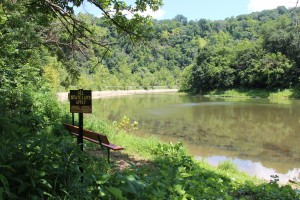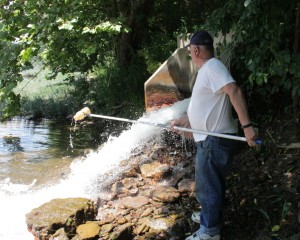False positive results of radioactivity suspected in Greene County stream
-
Reid Frazier/The Allegheny Front

Reid Frazier/ The Allegheny Front
The DEP found high radium readings along Ten Mile Creek in southwestern Pennsylvania.
New test results from a Greene County stream show much lower levels of radioactivity than state samples revealed last year, leading one researcher to suspect the state came up with a false positive.
More tests are expected in the coming months to determine if high levels of radium are seeping out of an abandoned mine upstream of a major drinking water source.
Elevated levels of radium, a material found in abundance in the Marcellus Shale, were found in a mine discharge along Ten Mile Creek last year, triggering concerns that illegal dumping of drilling waste had occurred there.
A team of scientists at West Virginia University sampled the discharge six times in July and August. They found only small amounts of radioactivity, all within federal drinking water guidelines, said Paul Ziemkiewicz, a West Virginia University forest ecologist and director of the West Virginia Water Research Institute.
“I had to come to a conclusion there really is not a radioactivity problem coming out of Clyde Mine that I could find,” said Ziemkiewicz.
An April, 2014 test at the site by the Department of Environmental Protection revealed levels of radium-226 and radium-228 at levels 60 times higher than federal drinking water standards.
The 2014 DEP tests came as a result of complaints from the Izaak Walton League, a local conservation group, about pollution in the stream.
The group found high concentrations of bromides, salts that can form carcinogenic compounds in treated drinking water.
Since bromide levels are typically higher in gas drilling waste than abandoned coal mine drainage, the group suspected illegal dumping of drilling waste was the cause.
Ten Mile Creek flows into the Monongahela River, which provides drinking water for hundreds of thousands of people in southwestern Pennsylvania, including parts of Pittsburgh. The stream contains treated acid mine drainage from the nearby abandoned Clyde coal mine.

Reid Frazier
Ken Dufalla samples water at the Clyde Mine discharge along Ten Mile Creek in July, 2015.” credit=”
The DEP didn’t release its 2014 test results until June, when an environmental group requested the results under the state’s Right-to-Know law.
Ziemkiewicz suspects that the high radioactivity levels found in 2014 may have been a false positive, and that the DEP used the wrong type of test. The DEP used gamma spectroscopy, which detects the gamma rays coming off of radioactive materials. Ziemkiewicz says the test is best for solid materials, but not fluids.
“We asked them and they admitted they were using gamma spectroscopy,” Ziemkiewicz said. “It’s cheap, it’s quick, but it’s not very precise. And it’s not the method you would use for testing water.”
DEP spokesman John Poister, when asked about the testing method used in 2014, responded via email.
“Gamma spectroscopy is an inexpensive screening tool that provides a broad view of gamma particles in a sample,” wrote Poister.
In its follow-up studies, Poister said the agency will test for radium using an EPA-approved test that will “provide a more precise result.”
Ziemkiewicz said he used both the EPA method as well as another method used when testing high-salt waters like mine drainage.
Ken Dufalla, local director of the Izaak Walton League, has been sampling the stream for the past four years.
“If Paul is correct, thank God that it’s not in our water,” he said. “Hopefully the 2014 testing was done wrong—that would be better for our water quality and safer for our people.”
But Dufalla said he’s not convinced of an ‘all-clear’ sign yet. Two other university groups are testing the water, along with the DEP.
“Other tests are being done,” Dufalla said. “When the Izaak Walton League receives all the results, and we can look at all the data, then we’ll make a conclusion.”
















